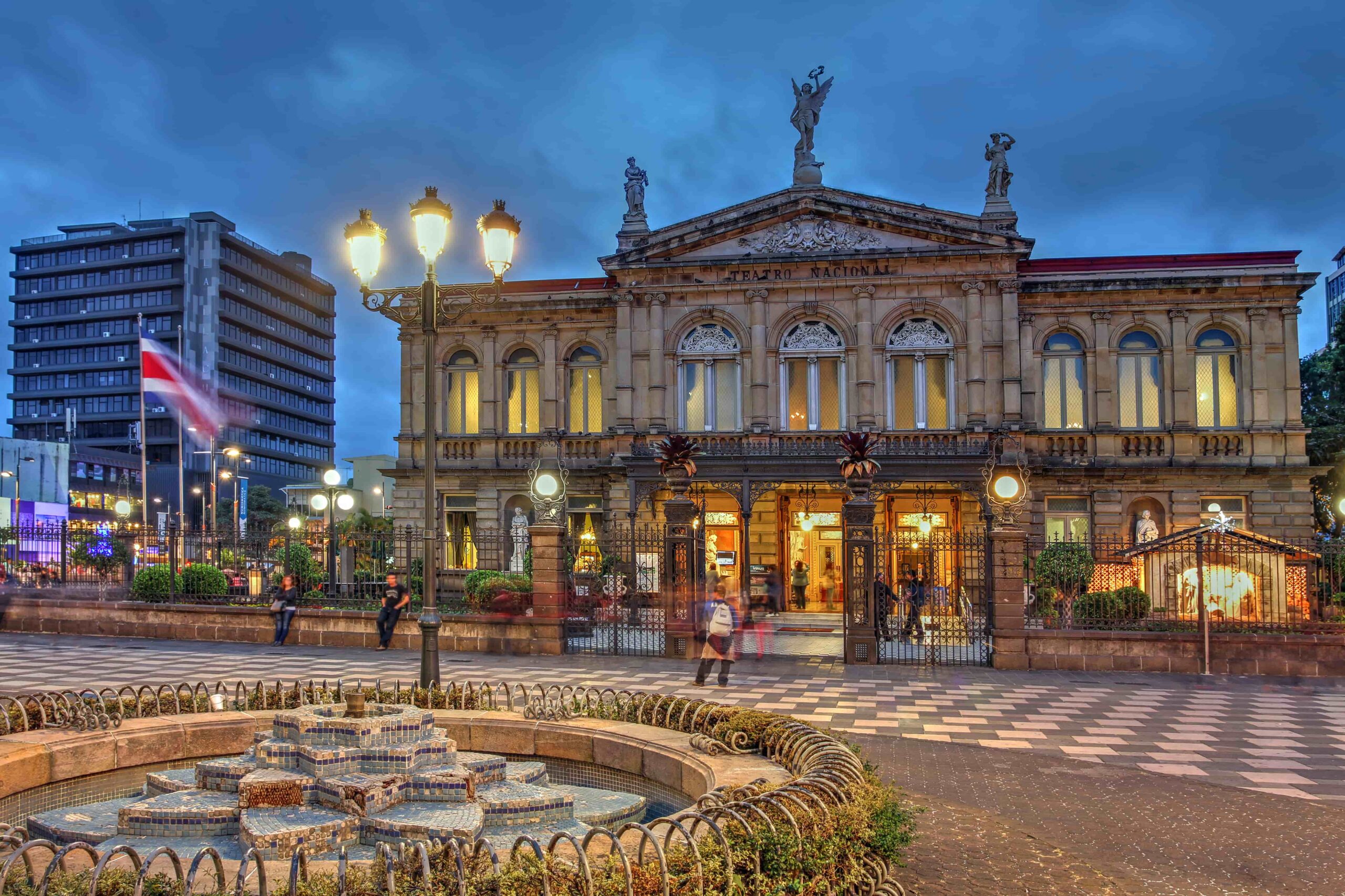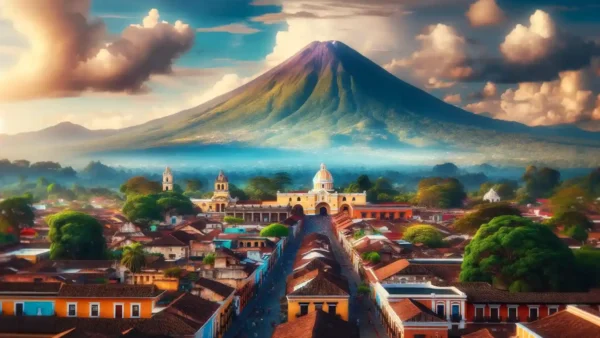Situated in the heart of San José, on the east side of Plaza Juan Mora Fernández, the National Theater of Costa Rica is not merely a functional venue—it stands as the most significant theater in the country. Recognized as a property and architectural jewel of the city, it holds the esteemed status of a historical heritage site.
The Teatro Nacional Theater is the most important theater in Costa Rica, considered a cultural and architectural gem in the heart of San José. Designated as a historical heritage site, it plays a crucial role in the national identity and showcases the country’s commitment to cultural development.
Situated on the east side of Plaza Juan Mora Fernández, between 3rd and 5th streets on Second Avenue, the Teatro Nacional Theater of Costa Rica boasts historicist architecture, completing its construction in 1897. This iconic building symbolizes the Costa Rican people’s determination and economic stability during the 19th century, shaping the country’s identity.
The Teatro Nacional Theater serves as a hub for national and international artistic endeavors, hosting state visits and cultural events. It has become a symbol of unity and cohesion for Costa Ricans, offering a space for entertainment, social gatherings, and spiritual enrichment.
The key components of the Teatro Nacional Theater include the façade, lobby, main staircase, foyer, and auditorium. No expense was spared during its construction, utilizing precious woods, imported iron, marble, gold, and French glass. The construction process, initially estimated at two years, took six years due to its intricate design.
Guided tours of the Teatro Nacional Theater showcase its exquisite Renaissance architecture in the purest neoclassical style, featuring Italian marble and interior decorations depicting scenes from coffee harvesting. Among its renowned works is the oil painting “Allegory of Trade and Agriculture of Costa Rica” by Aleardo Villa, known as the “Allegory of Coffee and Banana.”
The auditorium is a highlight, equipped for various artistic presentations. The unique raising mechanism of the rear window floor adds to its charm, allowing it to be rotated counterclockwise, aligning with the stage for a seamless transition.
Since the late 1960s, the Teatro Nacional National Theater has offered guided tours in both Spanish and English, inviting visitors to immerse themselves in its rich history. As a heritage site, it holds countless stories and secrets that come to life when experienced in silence. Teatro Nacional National Theater is one of the Things to do in Costa Rica.
The National Theater invites you to immerse yourself in its infinite beauty. The auditorium’s unique features, such as the rotatable lifting mechanism of the rear window floor, enhance the experience. As you witness its grandeur, the theater silently reveals its secrets, welcoming you with open arms to an extraordinary journey through time and culture.
Annually attracting 50,000 tourists and around 20,000 Costa Ricans and school groups, the theater strives to extend its reach beyond the local population. Advanced technology, through the Internet and the current technological platform, facilitates instant global outreach.
Teatro Nacional Location and Architecture
The theater’s strategic location on Second Avenue, between streets 3 and 5, invites exploration. Completed in 1897, this historicist architectural marvel is a cornerstone of national history. Constructed with precision and purpose, it reflects Costa Rica’s decision to pursue economic stability and cultural prominence through the arts.
Teatro Nacional Cultural Symbol and Purpose
From its inception, the National Theater has transcended being a mere building; it has become a cultural symbol. Commissioned as an intellectual project in the 19th century, it represents the essence of Costa Rican identity. Functioning as the house of international and national artists, a venue for state visits, and a hub for cultural events, it plays a vital role in fostering cohesion and joy within the community.
Teatro Nacional Architectural Marvels
The theater’s architectural splendors include the façade, lobby, main staircase, foyer, and auditorium. The construction, lasting six years, spared no expense. Precious woods from Alajuela, imported iron, gold, marble, and French glass were meticulously incorporated into its design. Designed by a French architect, not Charles Garnier, but around the same era, you can unmistakably sense the influence of that period. The space is nothing short of amazing and beautiful.
On a guided tour, one is captivated by Renaissance architecture, characterized by neoclassical purity. The interiors, adorned with Italian marble, depict scenes from coffee harvesting, showcasing the economic life of Costa Rica in the late 19th and early 20th centuries.
The Allegory of Trade and Agriculture
One of the most renowned works within the theater is “The Allegory of Trade and Agriculture of Costa Rica,” an oil painting by Aleardo Villa. Depicting the country’s economic life centered around coffee and bananas, this masterpiece was even reproduced on the 5 colones bill for decades.
Teatro Nacional Guided Tours and Immersive Experience
Since the late 1960s, the National Theater has opened its doors to guided tours in both Spanish and English. As a heritage of Costa Ricans, it carries a rich history that unfolds in silence. The auditorium, with its lifting mechanism, offers an impressive venue for various artistic presentations.
A Glimpse into Teatro Nacional’s Rich History
Step back in time as we delve into the history of Teatro Nacional Theater. this cultural gem has witnessed centuries of artistic evolution and societal transformations. Each brick holds a story, and every corner echoes with the whispers of performances that have graced its illustrious stage.
Less than 20 years had passed since the country gained independence from Spain, and the Ticos were already inaugurating their first theaters. It was the year 1837, and things were markedly different. The initial Costa Rican theater could accommodate only 70 people, housed in a mere straw shed where spectators brought their own chairs.
When the National Theatre of Costa Rica was established in 1897, it reflected the jubilation of a community that esteemed art, education, and culture. In those early days, the contrast with the makeshift beginnings was stark, highlighting the evolution of cultural spaces.
Teatro Nacional Theater Opening Timings
The theater operates on a special summer schedule from December 1st to April 30th, opening every day of the week from 9 a.m. to 6 p.m. The regular schedule, spanning from May 1st to November 30th, runs Monday to Saturday, from 9 a.m. to 4 p.m. In both schedules, visitors can explore the theater independently or opt for a guided tour.
Things to Know Before You Go Teatro Nacional
- For popular performances, it is recommended to buy tickets in advance.
- If attending a performance, dress in appropriate theater-going attire; for example, shorts, sandals, and flip-flops are not allowed.
- Arrive early, as late-comers will not be seated.
- Children under 4 years old are not allowed in the theater.
Frequently Asked Questions (FAQ) – Teatro Nacional Theater
- What is Teatro Nacional Theater?
Teatro Nacional Theater is a prominent cultural landmark located in the heart of San José, Costa Rica. It stands as a testament to the country’s rich history and architectural heritage. - When was Teatro Nacional Theater built?
The construction of Teatro Nacional Theater was completed in 1897. It represents a significant period in Costa Rican history and culture. - Who designed Teatro Nacional Theater?
Teatro Nacional Theater was designed by a French architect, not Charles Garnier, but around the same time as the construction of the Paris Opera. The influence of this era is evident in the theater’s architecture. - What makes Teatro Nacional Theater unique?
Teatro Nacional Theater is renowned for its historical value, architectural grandeur, and cultural significance. It serves as a hub for various artistic expressions, making it a vital part of Costa Rican identity. - Can I visit Teatro Nacional Theater?
Absolutely! Teatro Nacional Theater is open to the public, offering guided tours in both Spanish and English. Visitors have the opportunity to explore its beautiful interiors, including the façade, lobby, main staircase, foyer, and auditorium. - Is there an admission fee for Teatro Nacional Theater?
Yes, there is an admission fee for guided tours. The fees may vary, so it’s advisable to check the official website or contact the theater for the most up-to-date information. - What events take place at Teatro Nacional Theater?
Teatro Nacional Theater hosts a wide range of events, including classical concerts, plays, and special cultural performances. The theater’s calendar is diverse, offering something for every art enthusiast. - Can I host events or parties at Teatro Nacional Theater?
Yes, Teatro Nacional Theater provides a stunning venue for special events, parties, and banquets. The unique feature of the floor being raised using a pulley system adds versatility to the space. - How can I contribute to the preservation of Teatro Nacional Theater?Contributions to the preservation and maintenance of Teatro Nacional Theater are highly valued. You can inquire about donation programs, attend fundraising events, or simply support the theater by participating in its cultural programs.
- Is there parking available at Teatro Nacional Theater?
Yes, there is parking available near Teatro Nacional Theater. Visitors can check with the theater staff or refer to local parking facilities for convenient options.
In conclusion, the Teatro Nacional Theater is an enduring symbol of Costa Rican cultural heritage, inviting all to appreciate its infinite beauty and warm hospitality.




